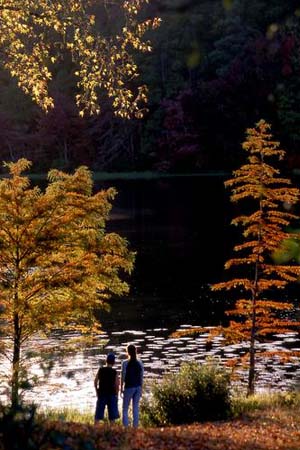Featured Park
Daingerfield State Park An Oasis For Harried Urbanites

In keeping with the Halloween spirit, the hardwood trees of Daingerfield State Park each autumn costume themselves in shades of gold, russet and burgundy, providing a stunning contrast to the evergreens that populate the rolling northeast Texas hills.
Some of the most rewarding stands of colorful sweet gum, red oak, maple, dogwood and sassafras, as well as Virginia creeper and flaming sumac, don their finest fall foliage in late October and early November. A stroll along several miles of woodland trails strewn with pine needles and pine cones circling 80-acre Lake Daingerfield provides some of the best vantage points to view the colorful display.
Fall rivals spring at this Pineywoods refuge 40 miles north of Longview as the most popular time of year to visit Daingerfield State Park, one of a handful of state parks tucked amid the pines in the northeast corner of the state. Lake Bob Sandlin, Atlanta, Cooper Lake, Tyler and Caddo Lake state parks all lie within a 40-mile radius of Daingerfield. The cooler weather, flaming and golden leaves and promise of pastoral repose draws thousands of overnight campers from the teeming Dallas-Fort Worth metroplex each autumn, says park superintendent John Thomas.
The Metroplex is still growing leaps and bounds, and people there are looking for a quiet place to go, Thomas said. They can get on I-30 and be here in two and a half hours, arriving in a completely different atmosphere than theyre used to. They come here for the serenity and outdoor scenery.
What visitors find at Daingerfield State Park is a cozy, 550-acre recreational area developed by the federally funded Civilian Conservation Corps between 1935 and 1938. CCC workers constructed an earthen dam to impound the small lake and retaining walls, surveyed a winding road through the woods and built three cabins, a lodge, boathouse and stone concession building.
The three wood-framed cabins, which were recently renovated, are especially popular during the colder winter months. Two four-person cabins feature central air and heating, two bedrooms, double beds and a kitchen with modern appliances. One is ADA accessible. The third cabin, Cabin No. 1, has three bedrooms and accommodates six people. All three have screened-in front porches to take advantage of the fresh air and soothing views. On a nearby hilltop, the five-bedroom, two-bath Bass Lodge can handle larger groups. It features a rock fireplace, outdoor patio and grill. Park patrons share their scenic environment with a variety of wildlife, including white-tailed deer, raccoons, armadillos, gray fox and an occasional bobcat. Throughout the year, the lake draws a sizable population of ducks, geese and other waterfowl.
Thomas touts the small, spring-fed lake as one of the parks greatest assets. Unlike some of the surrounding state parks that boast much larger impoundments that draw the big bass boats, Daingerfield offers a no-wake lake thats ideal for canoeists, kayakers and trolling boats.
Anglers will be glad to know Texas Parks and Wildlife alternately stocks Lake Daingerfield with largemouth bass and catfish. Crappie, sunfish and the unusual chain pickerel a Southern strain of Northern pike provide plenty of fun fishing opportunities. A boat dock, launching ramp, newly rebuilt fishing pier and fish-cleaning facility cater to fishermen. Daingerfield offers 52 campsites 10 with full hookups, 30 with water and electric service and 12 with water only in four different camping loops. Restrooms with and without showers, a playground with slides and swings, lakeside amphitheater and group picnic area with tables round out the park facilities.
Park visitors seeking exercise as well as knowledge will want to check out the Rustling Leaves Nature Trail. Before your trek, pick up a trail guidebook and look for numbered posts that correspond to information about the parks diverse flora and fauna. Youll find information on a variety of hardwoods, such as the white oak, the short leaf pine and more unusual species like the Eastern hop hornbeam whose tough wood is used for tool handles and mallets.
One plant that first-time visitors to Daingerfield State Park should be especially aware of is poison ivy that grows throughout the park. Learn to identify the vine, and look but dont touch its brightly colored leaves.
Daingerfield State Park is one of 93 state parks that make up the Texas State Park System. The park is located two miles east of Daingerfield off State Highway 49 on Park Road 17. From Dallas/Fort Worth, its approximately 22 miles from the Interstate 30 exit (Ferguson Road) in Mount Pleasant, via State Highway 49 to the state park. For more information about Daingerfield State Park, call (903) 645-2921. To learn about all Texas state parks, call (800) 792-1112, or log onto the Texas Parks and Wildlife Web site: www.tpwd.state.tx.us.
 Texas Parks and Wildlife Department, 4200 Smith School Road, Austin, TX 78744
Texas Parks and Wildlife Department, 4200 Smith School Road, Austin, TX 78744


